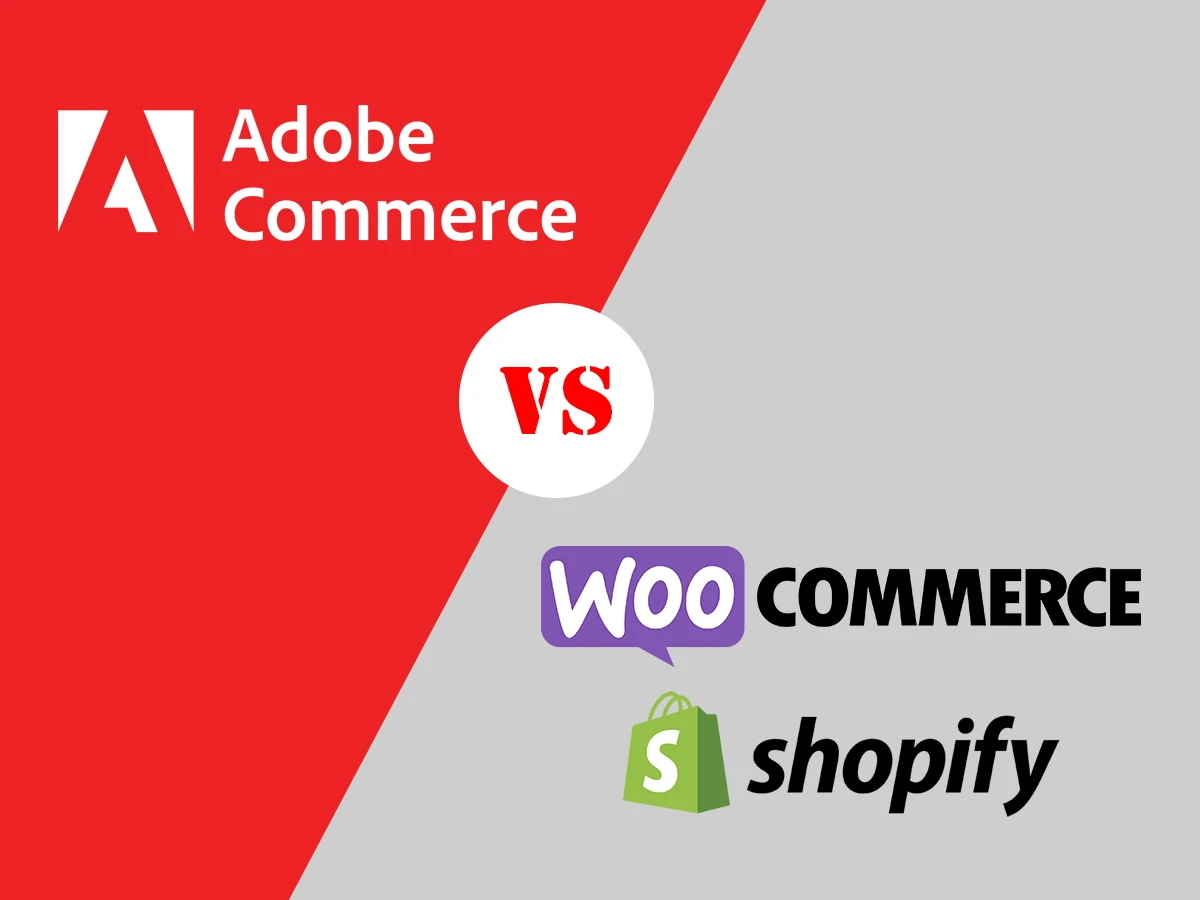
Comparing Adobe Commerce with Other E-Commerce Solutions: Advantages and Disadvantages
Adobe Commerce (Magento), E-commerce
14 June 2024
In today’s competitive e-commerce landscape, choosing the right platform is crucial for business success. Adobe Commerce (formerly Magento) is one of the leading e-commerce solutions, offering robust features and flexibility. However, it’s essential to compare it with other popular solutions like Shopify and WooCommerce to understand its unique advantages and potential drawbacks. This article delves into the features, strengths, and limitations of Adobe Commerce and compares it with other prominent e-commerce platforms.

Adobe Commerce Overview
Adobe Commerce, part of the Adobe Experience Cloud, is a powerful e-commerce platform designed to provide comprehensive solutions for businesses of all sizes. It offers extensive customization options, scalability, and a rich set of features that cater to various e-commerce needs.
Features of Adobe Commerce
- Customizable Storefronts: Highly flexible and customizable design options.
- Advanced SEO Tools: Built-in SEO features to improve search engine rankings.
- Multichannel Commerce: Support for multiple sales channels, including B2B and B2C.
- Integrated Marketing Tools: Tools for personalized marketing and promotions.
- Robust Security: Advanced security features to protect your store and customer data.
- Scalability: Ability to handle large product catalogs and high traffic volumes.
Strengths of Adobe Commerce
- Flexibility: Extensive customization options for tailored e-commerce experiences.
- Scalability: Suitable for both small businesses and large enterprises.
- SEO and Marketing Tools: Advanced tools to enhance online visibility and customer engagement.
- Integration with Adobe Experience Cloud: Seamless integration with other Adobe products for comprehensive digital marketing strategies.
Limitations of Adobe Commerce
- Complexity: Can be complex to set up and manage, requiring technical expertise.
- Cost: Higher initial setup and maintenance costs compared to some other platforms.
- Learning Curve: Steeper learning curve for users not familiar with technical aspects.
Key Differences Between Adobe Commerce and Other E-Commerce Solutions
Customization and Flexibility
Adobe Commerce
- Advantages: Highly customizable, allowing for unique and tailored e-commerce experiences.
- Disadvantages: Customization requires technical knowledge, which may necessitate hiring developers.
Shopify
- Advantages: User-friendly with easy-to-use templates and customization options.
- Disadvantages: Limited customization compared to Adobe Commerce.

WooCommerce
- Advantages: Open-source and highly customizable, suitable for businesses with technical expertise.
- Disadvantages: Requires WordPress knowledge and can be complex to manage.

Ease of Use
Adobe Commerce
- Advantages: Powerful features and tools once set up.
- Disadvantages: Complex setup process with a steeper learning curve.
Shopify
- Advantages: Extremely user-friendly, with easy setup and management.
- Disadvantages: Less flexibility in customization.
WooCommerce
- Advantages: Integrates seamlessly with WordPress, easy to use for those familiar with WordPress.
- Disadvantages: Can be difficult for users not familiar with WordPress.
Scalability
Adobe Commerce
- Advantages: Highly scalable, capable of handling large volumes of traffic and extensive product catalogs.
- Disadvantages: Requires significant resources and management as it scales.
Shopify
- Advantages: Scales well with various plans to accommodate growing businesses.
- Disadvantages: Limited customization as the business scales.
WooCommerce
- Advantages: Scales well with the right hosting and setup.
- Disadvantages: Requires continuous optimization and management.
Cost
Adobe Commerce
- Advantages: Provides extensive features and scalability, which can justify the cost for larger businesses.
- Disadvantages: Higher upfront and maintenance costs.
Shopify
- Advantages: Clear pricing plans with lower initial costs.
- Disadvantages: Additional costs for apps and integrations.
WooCommerce
- Advantages: Free core plugin with flexible pricing for additional features.
- Disadvantages: Costs can add up with hosting, themes, and extensions.
Advantages of Adobe Commerce
- Comprehensive Feature Set: Includes everything from SEO to advanced marketing tools.
- Flexibility and Customization: Allows for tailored solutions to meet specific business needs.
- Scalability: Capable of growing with your business, handling large volumes of traffic and products.
- Integration Capabilities: Seamlessly integrates with other Adobe Experience Cloud products and third-party tools.
Disadvantages of Adobe Commerce
- Complexity and Learning Curve: Can be challenging to set up and manage, requiring technical expertise.
- Cost: Higher initial and ongoing costs compared to other platforms like Shopify and WooCommerce.
- Resource Intensive: Requires significant resources for management and optimization.
Conclusion
Adobe Commerce stands out as a powerful and flexible e-commerce solution, ideal for businesses looking for extensive customization and scalability. While it offers a comprehensive set of features and integration capabilities, it comes with higher costs and a steeper learning curve. Comparing it with other solutions like Shopify and WooCommerce, Adobe Commerce is best suited for businesses that need advanced customization and are prepared to invest in technical resources.
For more information on Adobe Commerce and how it can benefit your business, visit the Adobe Commerce page on Leads Technologies.


